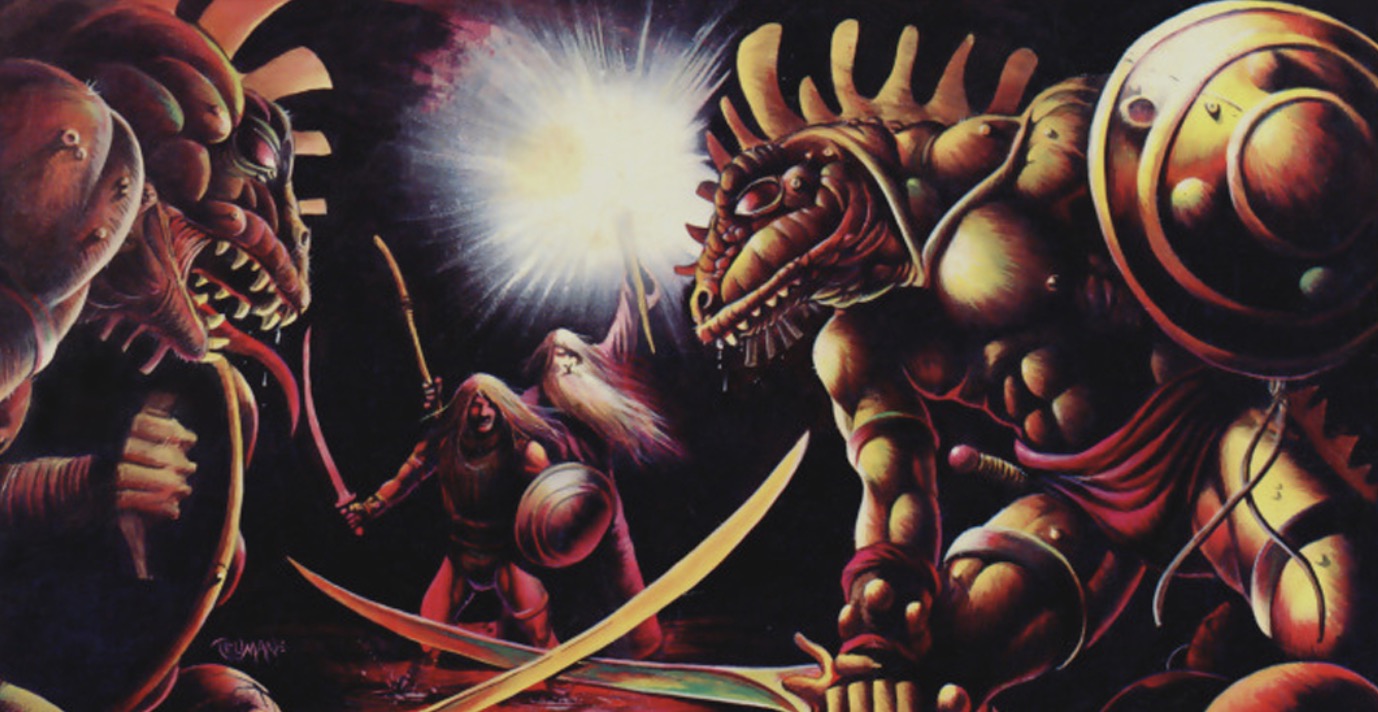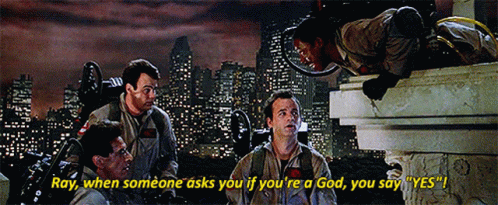Last Updated on January 22, 2023
I love cults. The fictional kind, not ones like [REDACTED FOR LEGAL REASONS] with their predatory business practices, crappy products that nobody wants, and sweaty, desperate sales reps reaching out on Facebook to see if I’m “Doin’ okay, hun.”
I love the good kind of cults. The kind of cults enthralled by terrifying mystics that Conan slew in their decadent snake temples. The kinds of cults that burned Nicholas Cage alive and summoned the devil in New York brownstone apartments. Isolated communities cut off from the horrors of the modern world who, in their solitude, brewed a horror all their own. You know, the kinds of cults that made H.P. Lovecraft’s palms get sweaty.
If you’ve ever played D&D with me (or talked to me for any amount of time for that matter), this is probably not news.
Aside from a good old-fashioned creature feature, horror films and thrillers about cults absolutely crowd my list of genre favorites. From slow burners like The Invitation and Rosemary’s Baby to Midsommar, Hereditary, Apostle, The Wicker Man (1973), The Ritual, and even the slightly sloppy Lovecraftian unease-fest that is The Endless, I just freaking love a good cult movie. For all of its style over substance and almost total lack of any subtextual plot and nuance, I even had a great time with Mandy, almost entirely thanks to Linus Roache’s absolutely blood-curdling performance as the leader of the Children of the New Dawn.

Some of my favorite adventures (Against the Cult of the Reptile God, Vecna Reborn, and Lorn Song of the Bachelor — not to mention the classic B2 Keep on the Borderlands) all revolve around cults worshiping or in service to something unsettling and doing horrible things in their name.
My homebrew campaigns pretty much all have at least one cult knocking around (preferably two that are at war with one another for added shenanigans) and up to no good. Sometimes that means a clutch of fanatical, leather-clad demon worshipers, and other times it’s just a group of otherwise perfectly normal villagers who accept the fact of life that, if they want the corn to grow tall and goblins to stay away from their farms, once a year they need to drag a screaming child to the altar in the deep woods.
So yeah, I love cults. And, more importantly, I love all different flavors of cults, which is a shame because, in a lot of D&D adventure writing (my own included if I’m being honest), “cult” has become a kind of shorthand for “irrational evil people with a loyalty card from discount cloaks and wiggly knife emporium.”

In honor of this being the spooky season and because sometimes your players deserve better than wiggly-knife-wielding dudes in cloaks, I wanted to examine why cults in D&D often look so different from real-world cults (and if that’s a bad thing) and then look at a new kind of cult you can use in your own campaigns.
Cults in D&D vs. The Real World
Cults (or New Religious Movements if we’re not looking to get sued) in the real world often look very different from the various demon or dragon-worshiping groups that crop up regularly in D&D. There’s a reason for this that is worth exploring two-fold.
First, let’s look at three warning signs that, in the real world, you might be in a cult. There are other lists presented in different ways that are out there, but this checklist written by psychiatrist Robert Jay Lifton nails it down pretty well in his description of three characteristics shared by destructive cults.
1. A charismatic leader, who increasingly becomes an object of worship as the general principles that may have originally sustained the group lose power. That is a living leader, who has no meaningful accountability and becomes the single most defining element of the group and its source of power and authority.
2. A process of indoctrination or education is in use that can be seen as coercive persuasion or thought reform (commonly called “brainwashing”).
3. Economic, sexual, and other exploitation of group members by the leader and the ruling coterie.
Now, compare this to some of the cults in D&D, like, for example, the long-dead cultists in the Death House or the Acererak-worshiping Cult of the Devourer who exist throughout Greyhawk and the Forgotten Realms. First, these cults tend to have an object of worship that is separate from their actual leader. The Death House cultists worshiped count Strahd, Barovia’s darklord, in the hope that he would grant them favors (he didn’t), and Acererak the demilich is locked away deep within the Tomb of Horrors as his mind explores the farthest reaches of the multiverse — wholly unconcerned with the actions of his followers.
Then, as far as I know, neither of these cults need to do very much brainwashing of their prospective members in order to get them to buy into the worship of their “leaders.”
The purpose of brainwashing is to loosen someone’s grip on reality enough that you, the brainwasher, become their reality. That’s how you convince people that you’re a god, to make them kill for you, or to kill themselves. That’s why psychedelic drug usage, isolation from existing support networks like family, and psychological abuse are such recurring themes in stories about cult indoctrination.
A cult in D&D, by comparison, is actually a much more rational proposition.
Think about it: cults, religions, shamanic spiritualism, you name it — it all works after a certain point on faith. Belief without proof. Members of a cult that worships Tiamat, the queen of evil dragons, all grew up in a world where her existence was an undisputed fact; not in the way that God was an undisputed fact in medieval Europe but a verifiable, empirically measurable thing in the world. Maybe they haven’t seen Tiamat with their own eyes, but they’ve seen what she’s done, and they know she’s out there.
Being a cultist in D&D is less like being a member of the [REDACTED FOR LEGAL REASONS] or any other group of nut jobs that recruit child celebrities to boost their reputation and more like being an Elon Musk fanboy on Twitter. He’s out there in the world. He exists. He’s powerful. He’s widely reviled, admired, and feared. And maybe if you do something crazy enough, he’ll tell you he’s proud of you like your father never did.
Honestly, I could devote a whole article to the fact that religion in D&D (a multiverse where gods, devils, and all manner of other stuff empirically exist) should actually work very differently from how it does in the real world, but that’s another thing for another time. Right now, let’s just focus on the fact that cults in D&D might worship dragons and evil dead wizards, but they’re weirdly a bit saner than the ones that exist in the real world.
Lastly, there’s the idea of exploitation, which is the one I see the least in D&D.
In the real world, cult leaders and their inner circles take from their followers (whether it’s money, sex, power, adoration, or any number of other royally messed-up things), and in return, they give hope, a sense of belonging, “universal truth,” a place on the ark when the bomb goes off, or the promise of eventually joining the inner circle and doing some exploiting of your own.
Cults are ultimately a grift. They’re a way for people to exercise power over and exploit others. This, again, doesn’t line up with how cults work in D&D (or any media where the thing they’re actually worshiping is real). The devil worshipers in Rosemary’s Baby aren’t being exploited by the devil; they really do impregnate that woman with the goddamn antichrist. On the other hand, the Children of the New Dawn in Mandy are absolutely being grifted by Jeramiah Sands; he’s an LSD-peddling sex maniac who hires psychotic sadomasochistic biker-demons to do his dirty work with the blood of his own followers. But, while the movie definitely plays on the uncertainty over what’s real and what isn’t, there’s nothing truly inexplicable that happens: visions are just psychotic episodes or drugs, the demon bikers are just really messed-up people, and no one is immortal in the end.
My point is that if the thing the cult worships is an actual supernatural god that can legitimately give people what they want from it, then it’s in line with a D&D cult, which is more akin to a parasocial relationship with a podcasting personality or how a lot of weirdos seem to think about Silicon Valley tech bros.
If not, then it’s a grift, and when we put that idea into D&D, then we get something else.
Building a Better Cult or “That Giant Snake’s Nothing But a Low-Down Dirty Grifter!”
So, what happens when we take the traits that are commonly assigned to real-world cults (a charismatic leader that is living and present within the cult, brainwashing, and exploitation) and put them in D&D?
Do we unlock the secret to a new way of dealing with cults that lends a fresh perspective to the whole— Ah hell. We just made Against the Cult of the Reptile God, didn’t we?

Written by Douglas Niles and released in 1982 as the first in the “Novice” line of adventure modules for AD&D 1st Edition, Against the Cult of the Reptile God is rightly held up as one of the best starter adventurers of all time. It’s got a town, a mystery to solve, NPCs to talk to, and a sinister plot underpinning the proceedings.
SPOILERS. What’s happening is that a spirit naga called Explicita Defilus has taken up residence in the nearby swamp and, with the help of the local lizard men, has “installed itself as a god,” magically dominating kidnapped townsfolk (those who resist are fed to the naga’s pet crocodiles) who are then sent back to the village of Orlane to further spread the word of the cult, not to mention give the cult all their worldly possessions.
So, let me check.
- A charismatic leader who is present at the head of the cult? Despite being a giant snake with a human face, Explicita Defilus definitely compels the loyalty of her followers.
- Brainwashing? Of the magical rather than the psychologically abusive variety, but if it ain’t broke, don’t fix it.
- Exploitation? Oh absolutely. More than any other adventure I’ve read, the cult in Against the Cult of the Reptile God actually exploits its members. They are required to send everything they have of value away through the swamp in caravans that leave from the local cultist headquarters. When the adventurers finally confront the spirit naga in her dark cave beneath the fetid earth, she slithers atop a gleaming pile of gold…
So, how is this spirit naga any different from Orcus, Vecna, or Tiamat? Well, first of all, the people who serve those entities are working for them, not necessarily being exploited by them. Sure, the hours probably aren’t very good, and I would imagine you can’t exactly give your two-week notice and seek gainful employment elsewhere, but that’s par for the course for your average goon, and no one ever accused Dr. No or Blofeld of being a cult leader.
Not only is Explicita Defilus exploiting her brainwashed followers in exchange for, well, not much, but she’s also not a god. In AD&D, a spirit naga had between 7 and 12 HD, making it a pretty beefy customer, and in 5e, it’s a CR 9 monstrosity… Nasty? Sure. A god? No.

Explicita Defilus, the “Reptile God” is nothing but a low-down dirty grifter!
Sure, she’s a 15-foot-long snake woman with mind control powers, but in D&D terms, that’s much closer to your average peasant than a spirit naga is to being a god.
Therefore, while this means that what I’m going to suggest you do to get better cults in your games isn’t actually that original, it has precedent and gives us a playbook to follow when bridging the gap between charismatic yoga instructor with some unorthodox views on monogamy and Orcus the demon prince of undeath. Yep, let’s use Explicita Defilus as a template for a totally new kind of cult you can put in your D&D campaign: the Fantasy Grifter Cult or Not Really Magical cult (NRM for short).
Time Shares and Glittering Sex Magic in Central Faerun
Much like real-world cults rely on people being insufficiently informed to tell the difference between a charismatic sociopath in a bathrobe they stole from the Radisson Blue and Jesus Christ reborn, our fantasy grifter cult is going to need a target audience.

Desperate, downtrodden, misinformed people do best, preferably in a location that’s somewhat cut off from the outside world. Much like the village of Orlane is separated from other towns by a substantial trek through goblin and ogre-infested hills and woods, wherever you pick needs to be somehow isolated from the rest of the world.
Now, isolation doesn’t have to be geographical, and while small towns in the middle of nowhere or islands at the edge of the map are all great, a cult that entrenches itself in a city to prey upon its least fortunate is totally plausible.
Of course, any cult that starts being active near a big city like Waterdeep is going to face a great deal more scrutiny, and, to be honest, any passing Cleric with Zone of Truth prepared could spell the end of the organization, so it’s probably best to stick to the countryside. Yokels who can’t tell the difference between a dragon and a low-flying hawk are going to be easier to fool anyway.
Once the cult is established, we can spread it farther afield. Patience.
So, now that we have a target location, let’s go through the checklist.
Step One: A Charismatic Leader
Then, we need to think about the kind of person or creature that’s going to be able to command adulation and worship. Whether that’s through magical means, the force of their personality, some sort of accursed item, or a combination of all of the above and more is up to you.
Enchantment and Illusion wizards are a tempting choice here as are the faintly messianic undertones of the sorcerer, as anyone who can warp the perceptions and minds of others is going to be well on their way to convince a large number of people to call them “Exalted One” or whatever and give them all their stuff.
As far as creatures go, Fey are an obvious choice as they can sometimes pass for humans, but their otherworldliness is definitely beguiling. Many of them (like Hags) can disguise themselves to appear how they choose and have enough magical powers (not to mention potion-brewing expertise) to get step two underway.
Step Two: Brainwashing
Start small, either with a few adopted outcasts or a drunk snatched off the street and mind controlled. In many ways, the spreading of a cult is akin to the growth of a vampire infestation. The clues should start to show through, and people should behave contrary to their original nature. They should be resistant to criticism of the cult and may even turn to violence when people are revealed to be its enemies.
Most importantly (and this is somewhere that Against the Cult of the Reptile God falls a little short — thanks to the magical domination by the spirit naga, not a brainwashing in the classical sense), the people in service to the cult should love the cult. They need to be obsessed with it and convinced that the cult is finally allowing them to fulfill their wildest dreams — dreams from which their old lives and attachments (like families and religions) were only holding them back.
Step Three: Exploitation
Now it’s time to figure out what the cult leader gets out of their adoring supplicants. Now, keeping in mind the point I made above about the vampire infestation, this is definitely the hardest criterion to pin down in a world where there are soul-eating demons, vampires, and gods and where working for one of them is just another job with healthcare at the end of the day.
For it to be a grifter cult, the townsfolk need to be exploited in a way that obscures the nature of the cult leader.
Strahd is in many respects a charismatic god to the people of Barovia, but they aren’t lining up to bare their necks to the night sky in the hope that their resident darklord will swoop down and give them a neck biting of their own. They’re all perfectly aware of who and what he is. Ergo: not a grifter cult.
Now, a town that worships a vampire who pretends they’re not a vampire and that ritually bloodlet into a big communal goblet that mysteriously disappears every night in order to cleanse and purify their sins… 100% certified Grade A Grifter Cult.
Whether it’s food, money, blood, or whatever, the relationship must be obviously parasitic to an outsider and a fair exchange to those who are brainwashed.
Final Thoughts
So that’s my take on the difference between real-life cults and those in D&D, my tips on incorporating a more realistic version of cults into your Dungeons & Dragons campaign, and a quick look at someone who already did the exact same thing over 40 years ago. Looks like the only thing that won’t be coming back from the dead this Halloween is my belief in my own originality.
I played my first tabletop RPG (Pathfinder 1e, specifically) in college. I rocked up late to the first session with an unread rulebook and a human bard called Nick Jugger. It was a rocky start but I had a blast and now, the better part of a decade later, I play, write, and write about tabletop RPGs (mostly 5e, but also PBtA, Forged in the Dark and OSR) games for a living, which is wild.
